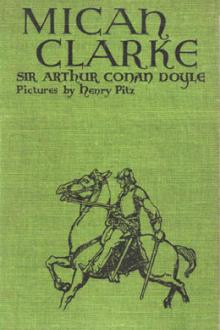Three Thousand Years of Mental Healing, George Barton Cutten [crime books to read TXT] 📗

- Author: George Barton Cutten
- Performer: -
Book online «Three Thousand Years of Mental Healing, George Barton Cutten [crime books to read TXT] 📗». Author George Barton Cutten
The once famous Dr. Newton arrived in Boston in 1859 on one of his visits, and caused an extraordinary sensation. Astonishing results were reported in the way of cures. The lame, having no further need of crutches, left them behind; the blind were cured, and several chronic cases were relieved. He had many followers and disciples among whom was "Dr." Bryant, who settled in Detroit and healed there. Rev. J. M. Buckley, D.D., met Dr. Newton on a Mississippi steam-boat, when the latter was returning from Havana with his daughter who was very low with consumption, and the father doubted if she would reach home alive. When asked "Doctor, why could you not heal her?" he replied "It seems as if we cannot always affect our own kindred." At this time he denounced his pupil, Dr. Bryant, as an "unmitigated fraud who had no genuine healing power."
"If Bryant be an unmitigated fraud, how do you account for the cures which he makes?" asked Dr. Buckley.
"Oh!" said the doctor, "they are caused by the faith of the people and the concentration of their minds upon his operations with the expectation of being cured. Now," said he, "nobody would go to see Bryant unless they had some faith that he might cure them, and when he begins his operations with great positiveness of manner, and when they see the crutches he has there, and hear the people testify that they have been cured, it produces a tremendous influence on them; and then he gets them started in the way of exercising, and they do a good many things that they thought they could not do; their appetites and spirits revive, and if toning them up can possibly reduce the diseased tendency, many of them will get well."
Said Dr. Buckley: "Doctor, pardon me, is not that a correct account of the manner in which you perform your wonderful works?"
"Oh, no," said he; "the difference between a genuine healer and a quack like Bryant is as wide as the poles."200
Father John of Cronstadt (1829-1908) was a saintly man, and furnishes us with an example of the healers among the Orthodox Church of the East. He was famed in all Russia for his sanctity, and was so thronged by crowds for his healing power that he often had to escape by side doors after celebrating the communion. His cures were many, but I choose his own account of one as an example.
"A certain person who was sick unto death from inflammation of the bowels for nine days, without having obtained the slightest relief from medical aid, as soon as he had communicated of the Holy Sacrament, upon the morning of the ninth day, regained his health and rose from his bed of sickness in the evening of the same day. He received the Holy Communion with firm faith. I prayed to the Lord to cure him. 'Lord,' said I, 'heal thy servant of his sickness. He is worthy, therefore grant him this. He loves thy priests and sends them his gifts.' I also prayed for him in church before the altar of the Lord, at the Liturgy, during the prayer: 'Thou who hast given us grace at this time, with one accord to make our common supplication unto thee,' and before the Holy Mysteries themselves. I prayed in the following words: 'Lord, our life! It is as easy for thee to cure every malady as it is for me to think of healing. It is as easy for thee to raise every man from the dead as it is for me to think of the possibility of the resurrection of the dead. Cure, then, thy servant Basil of his cruel malady, and do not let him die; do not let his wife and children be given up to weeping.' And the Lord graciously heard, and had mercy upon him, although he was within a hair's breadth of death. Glory to thine omnipotence and mercy, that thou, Lord, hast vouchsafed to hear me!"201
For the past century and a half healing has been carried on among the Pennsylvania Germans by means of a superstitious practice known as "Pow-wow." A book called The Sixth Book of Moses, or Black Art is said to be the basis of the practice. The practitioners are usually women of the most ignorant, degraded, and, not infrequently, immoral class, and in harmony with this, a firm belief in witchcraft is entertained by them. Notwithstanding this, they are employed at times by intelligent and respectable people, even by those whose standing in the community might well guarantee a disbelief in such incantations. The healers treat for burns, erysipelas and all skin diseases, goitre, tumors, rheumatism, and some other similar troubles. They have different formulas for the various diseases, and the belief is current that if a healer should reveal the formula to her own sex, she would lose her power, and if she told more than one of the opposite sex, the power would be taken from her. The following is the method of operating for burns:
"Take a piece of red woolen yarn and wrap it into the shape of a ball. Pass it slowly around the burn and while doing so, repeat three times, 'The fire burneth, water quencheth, the pain ceaseth.' After which reverse the movement and repeat the words again three times. Then take the yarn upstairs, pull out the chimney-stop, put the yarn in the chimney, and as soon as it disappears the burn is healed."
There have been a number of cases of local healers and I give two examples: "At the time of the prevalence of cholera in Canada, a man named Ayers, who came out of the States, and was said to be a graduate of the University of New Jersey, was given out to be St. Roche, the principal patron saint of the Canadians, and renowned for his power in averting pestilential diseases. He was reported to have descended from heaven to cure his suffering people of the cholera, and many were the cases in which he appeared to afford relief. Many were thus dispossessed of their fright in anticipation of the disease, who might, probably, but for his inspiriting influence, have fallen victims to their apprehensions. The remedy he employed was an admixture of maple sugar, charcoal, and lard."202
"The Month for June, 1892, published an account, by the late Earl of Denbigh, of a cure worked by a member of a family named Cancelli of Lady Denbigh in 1850. She was suffering severely from rheumatism, and the Pope (Pius IX) mentioned to the Earl that near Foligno there was a family of
peasants who were credited with a miraculous power of curing rheumatic disorders. Lord Denbigh succeeded in getting one of the family, an old man, to come, and learned from him the legend of the cure. The belief was that in the reign of Nero, the Apostles Peter and Paul took refuge in the hut of an old couple named Cancelli, near Foligno, and, as a proof of gratitude, gave to the male descendants of the family living near the spot the power of curing rheumatic disorders to the end of time. Lord Denbigh described how the old man made a solemn invocation, using the sign of the cross, and, in fact, Lady Denbigh did recover at once. In a few days the pains returned, but she made an act of resignation, and they then left her, and never returned with any acuteness."203
What we may designate "Metaphysical Healing" originated with Phineas Parkhurst Quimby (1802-1866). The movement was important, not so much on account of what Quimby himself was able to accomplish by it, as because of the work that has been carried on since by at least three of his pupils. He was born in Lebanon, New Hampshire, and in early life was a watch and clock maker. In 1840 he began experimenting with mesmerism, and accounts of these experiments were published in the Maine papers of that time. After this he developed a system of mental healing of his own, practising it in different towns in Maine for some years. About 1858 he settled as a practitioner in Portland and remained there until his death. I shall quote brief extracts in his own words, which portray his system.
"My practice is unlike all medical practice. I give no medicine, and make no outward applications. I tell the patient his troubles, and what he thinks is his disease; and my explanation is the cure. If I succeed in correcting his errors, I change the fluids of the system and establish the truth, or health. The truth is the cure. This mode of practice applies to all cases."
"The greatest evil that follows taking an opinion for a truth is disease."
"Man is made up of truth and belief; and, if he is deceived into a belief that he has, or is liable to have, a disease, the belief is catching, and the effect follows it."
"Disease being made by our belief, or by our parents' belief, or by public opinion, there is no formula to be adopted, but every one must be reached in his particular case. Therefore it requires great shrewdness or wisdom to get the better of the error. Disease is our error and the work of the devil."204
Quimby made many wonderful and mostly speedy cures, and although he wrote out his system, it has never been published. Among his patients was Mrs. Patterson from Hill, New Hampshire, who went to Portland in 1862. She had been a confirmed invalid for six years. To quote her own words, published in the Portland Evening Courier in 1862, she made a rapid recovery. "Three weeks since I quitted my nurse and sick room en route for Portland. The belief of my recovery had died out of the hearts of those who were most anxious for it. With this mental and physical depression I first visited P. P. Quimby, and in less than one week from that time I ascended by a stairway of one hundred and eighty-two steps to the dome of the City Hall, and am improving ad infinitum. To the most subtle reasoning, such a proof, coupled, too, as it is with numberless similar ones, demonstrates his power to heal." Mrs. Patterson, afterward Mrs. Eddy, proclaimed after his death a doctrine very similar to Quimby's. She called it "Christian Science," a name Quimby applied to his teaching, although usually he called it "Science of Health."
Another patient of Quimby's was Julius A. Dresser, who visited him first in 1860. Of him Mr. Dresser says: "The first person in this age who penetrated the depths of truth so far as to discover and bring forth a true science of life, and publicly apply it to the healing of the sick, was Phineas Parkhurst Quimby of Belfast, Me."
Rev. W. F. Evans was still another patient and disciple of Quimby's. His testimony is as follows: "Disease being in its root a wrong belief, change that belief and we cure the disease.... The late Dr. Quimby, of Portland, one of the most successful healers of this or any age, embraced this view of the nature of disease, and by a long succession of most remarkable cures ... proved the truth of the theory.... Had he lived in a remote age or country, the wonderful facts which occurred in his practice would have now been deemed either mythical or miraculous."
These three, Messrs. Evans and Dresser and Mrs. Eddy, proved to be Quimby's most famous patients and disciples. Evans became a noted and voluminous writer on mental





Comments (0)